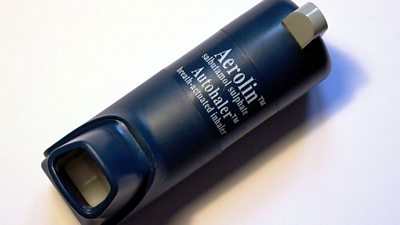What Can Go Wrong?
- Developing occupational asthma would be rare in the course of your work at the ����ý. However the most common substances that you may encounter are resin in solder fumes for those who carry out regular soldering work, and latex foam or isocyanate foam manufacture such as in the making of props visual effects etc.
- There are many substances that can cause occupational asthma but usually this would only be a problem where chemical substances or dusts are being released into the air and inhaled repeatedly over a period of time.
Legal/����ý Requirements
- Exposure to substances that could cause occupational asthma are covered by the COSHH regulations.
- A risk assessment of the work must be undertaken, and where appropriate health surveillance measures may be required.
Control Measures
General Controls
- Check the risk phrases of those substances you are using. Those marked R42 have the potential to cause occupational asthma.
- The risk of work with substances that could cause occupational asthma should be assessed, and control measures put in place to minimise exposure. In some circumstances this could be by using local exhaust ventilation.
- It is your duty to ensure you are familiar with the control measures in place to protect you and that you use them correctly.
- Health Surveillance is a regular enquiry into symptoms or regular testing such as lung function tests that can detect the signs of occupational asthma before serious symptoms develop.
- Ask your manager about health surveillance if you are regularly exposed to substances that could cause occupational asthma. This may result in an Occupational Health Referral.
- Talk to your manager at the earliest opportunity if you are experiencing health problems which you believe are related to the work you are doing, especially wheezing or an irritating night time cough and ask to be referred to Occupational Health.
- Check whether health surveillance (regular checks on respiratory symptoms or lung function testing is required).
Division Specific Issues
- No division specific issues.
FAQs/Did You Know?
- If you work with substances that could cause occupational asthma then a risk assessment should have been carried out – ask your manager to see it.
- Routine health surveillance can help detect symptoms or changes in the lung at an early stage to help prevent further more serious problems occurring. Your manager can refer you to Occupational Health if required.
Recommended links
-
[Gateway]
-
Workplace Health topics
-

Audiences and Visitors to the ����ý
Guide to safeguarding those visiting our premises or attending our events / shows. -

Display Screen Equipment (DSE)
Includes advice on completing assessments for various types of workstation and how to address any health issues. -

First Aid in ����ý Premises
This page also provides the arrangements and numbers for contacting ambulances and the National Central Control Room (NCCR). -

Legionella in Premises: Control of
This guidance provides an overview of how water systems are managed in premises to minimise the risks from the Legionella bacteria. -

Manual Handling
If your job involves lifting or carrying heavy or awkwardly-shaped equipment, or repetitive lifting, you need to know how to minimise the risk of injury. -

Noise at Work
Controlling the exposure to noise at work which can be harmful to one's hearing. -

Occupational Asthma
A guide to situations in which asthma could be caused by inhaling certain substances in the course of your work. -

Office Safety
This guide provides general advice for working in both ����ý offices and third party (non ����ý) offices. -

Personal Emergency Evacuation Plan (PEEP)
Guideline describing the measures to take to ensure those who need it can get assistance to evacuate a premises during a fire or other emergency. -

Shift Working and Night Shifts
The risks of shift working and how to minimise the effects of night shift working by taking care of your health and environment. -

Skincare and Dermatitis
A guide to looking after your skin and recognising the symptoms of dermatitis which is a reaction that occurs when our skin becomes inflamed.
More from SSR
-
Your platform to record accidents, risk assessments, assurance monitoring and inspections
-
Safety Equipment Stores
Just one number to call: 020 3614 5155 -
����ý Safety Guidelines
An A-Z of ����ý's Health and Safety Guidelines -
Safety Advice Line: 0370 411 0464 Email: safety@bbc.co.uk
Events guidance - key links:
- Exhibitions
- General Guidance
- Indoor Location Recce Checklist
- Outdoor Location Recce Checklist
- Major Incidents & Emergency Planning
- Marketing and Promotional
- Noise Exposure
- Planning and Management
- Responsibilities
- Responsibilities Form
- Laser Lighting Effects
- Strobe Lighting
- Temporary Stages and Rostra
Health topics - key links:
- (����ý network only)
- Contributors Fitness to Participate
- Display Screen Equipment (DSE)
- (����ý network only)
- First Aid and Welfare on Location
- International Travel - Risks & Health
- Manual Handling
- Mental Health: Homepage
- (����ý network only)
- Personal Health and Wellbeing
- Pregnancy
- Psychological Trauma Support & Trauma Risk Management (TRiM)
- Tiredness and Fatigue
- Travel Health Contacts
����ý High Risk - key links:
- CBRN and Industrial Spills
- Covert Filming
- Crisis Management and Security Support
- Demonstrations, Protests and Crowds
- Disaster Coverage
- Door Stepping
- (����ý network only)
- (����ý network only)
- Public Order
- Safety Equipment Stores
����ý Journalism - key links:
����ý Productions - key links:
- Aerial Filming and Airfields
- Animals: Displaying and handling for performance
- Boats: Working on
- Children and Young People
- Driving
- Electrical Equipment and Systems
- First Aid and Welfare on Location
- Food Safety (Cooking and Catering)
- Remote Location Working
- Roads and Streets: Working by
- Security of Productions on Location
- Stunts
- Tiredness and Fatigue
- Unmanned Aerial Systems (UAS aka Drones)
- Vehicles: Recording in, from and around
- Working at Height: Mobile Elevating Work Platforms
- Working at Height: Tower Scaffolds
����ý Radio - key links:
- (����ý Network only)
����ý Security - key links:
����ý Sport - key links:
About this site
This site describes what the ����ý does in relation to managing its health, safety and security risks and is intended for those who work directly for the ����ý.
It is not intended to provide instruction or guidance on how third parties should manage their risks. The ����ý cannot be held liable for how this information is interpreted or used by third parties, nor provide any assurance that adopting it would provide any measure of legal compliance. More information
Some links on this site are only accessible when connected to the ����ý network
